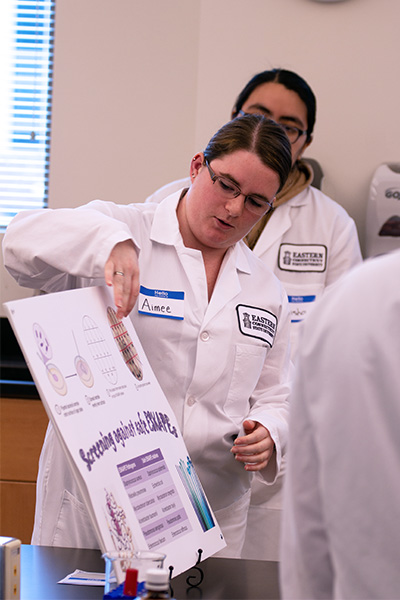- Apply
- Visit
- Request Info
- Give



Published on April 25, 2023
The global search for new antibiotics is getting a boost from Eastern Connecticut State University through an effort known as “Tiny Earth,” a network of researchers uniting against antibiotic resistance. On April 19, a dozen Norwich Free Academy juniors visited campus and had their soil samples analyzed for the Tiny Earth Day Symposium.
Students in biology Professor Jonathan Hulvey's advanced biology class demonstrated for the high school students the lab techniques used to extract bacteria from the samples. The bacterial isolates will be sent to a lab at the University of Wisconsin where chemical and genomics studies will look at the chemicals the bacteria produce and search for novel antibiotics.
The University of Wisconsin-Madison is the home of an international Tiny Earth network of researchers who are working to combat the diminishing supply of effective antibiotics. Barbara Murdoch, associate professor of biology at Eastern, was mentored at Yale University by the Tiny Earth founder, Jo Handelsman, who is now a research professor at UW-Madison and director of the Wisconsin Institute for Discovery, where Tiny Earth is based. Murdoch introduced Tiny Earth research at Eastern and Hulvey developed the Tiny Earth Day symposium here in 2019 as part of a general microbiology course.

Worldwide, 10,000 students in 15 countries and 45 states are participating in the Tiny Earth search for new antibiotics. Pharmaceutical companies have cut back on their own antibiotics research, finding bigger returns in other drugs, Murdoch said, even though antibiotic resistance is growing and is associated with more than 25,000 deaths a year in the United States.
The Tiny Earth symposium at Eastern has another goal, too – to introduce high school students to opportunities for undergraduate research. Eastern microbiology students working on the Tiny Earth project in Hulvey’s class are testing 15 bacteria that they have isolated for DNA sequencing from the Norwich samples. The Eastern students are learning lab procedures that will prepare them to work in a Biosafety Level 2 lab, said Hulvey – a lab that works on organisms that could be pathogenic.
“It’s an excellent opportunity to provide undergraduates a research program they otherwise wouldn’t have,” Murdoch said.
Billi Kozak ’24, one of those students, said they came to Eastern in part because of the opportunities here for undergraduate research and working closely with faculty. They have wanted to do microbiology research since being in the sixth grade. They presented their work to the Norwich students during the symposium. Their research is mentored by Hulvey and is abou a threatened caterpillar species and a virus that may be responsible for the decline of some butterfly species.
Stefanos Stravoravdis ’20, now a Ph.D. candidate in the microbiology program at the University of Massachusetts-Amherst, presented his latest research by Zoom. Stravoravdis first worked with Professor Patricia Szczys at Eastern on tern research and later with Hulvey before going to graduate school.
“Research is really cool not just because you learn and grow but because of how big the research community is,” he told the Norwich students.
Murdoch, who teaches microbiology to non-science majors, said many of her students go on to careers in health – as doctors and dentists and working in biotech, for example. Being exposed to the opportunities in science is a “transformative experience for most students,” she said. Participating in research inspires students to stay in STEM fields, she said.
Written by Lucinda Weiss